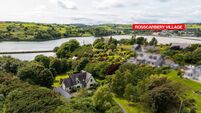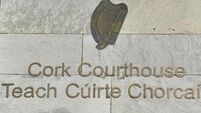Renovation hits the right buttons
This finished home is now notable for a materials’ palette that includes green marble terrazzo flooring, concrete, walnut and a soft and warm polished stucco plaster finish throughout
YOU don’t need large and spectacular sites, big bulging budgets and grand dreams with vaunting ambitions to create a quite perfect, calming, living environment. This Portobello Dublin terraced home is quiet testimony to this fact.
Well, it’s quiet at least and only when the son of the house isn’t skinning alive his drum kit in one of its two bedrooms.
This Victorian city terraced house’s renovation was finished off just last year for its owners, a French/Irish couple who’d lived here since the 1980s, and who’d extended once before — but badly.
This time around they wanted to create a calm, polished living and working space in the location they knew and were comfortable in, and were fortunate to come across architect Donal Colfer, “a friend of a friend”.
Modest in just about every way bar commitment to quality, the house grew only marginally, from about 850 sq ft to perhaps 1,100 sq — but every inch mattered. In fact, it mattered so much the back yard’s boundary wall was trimmed back to gain an extra, ‘mere’ four inches width of outdoor space. Compare that space paring and parsing to the wantonness of some of the Celtic Tiger blingtastic piles of the boom, where homes incidentally swelled by hundreds of square feet, and ‘design’ was for almost random thousands of square feet.
For the owners (the woman of the house is a fashion designer) of this Portobello home, small was to be beautiful, and indeed it is. So accomplished, in fact, the finished work has just achieved an enviable Architectural Association of Ireland (AAI) 2012 Special Mention Award.
It’s a project that Wexford-born architect Donal Colfer relished, and it’s refreshing to hear a design professional so enthusiastic, and so engaged with, a scheme where the total budget was also modest. Think comfortably under €150k for a full house renovation and overhaul, to the highest standards and craft execution.
The previous extension had had the often common effect of darkening and closing off the traditional ‘back room,’ and so the brief was to rediscover space, with light through, and — unusually enough — it included the rider that there wasn’t going to be much furniture, “and they weren’t interested in entertaining”. So, very much a calm, uncluttered and private space, please.
Colfer says, and gratifyingly so from his point of view, that the clients were willing to push the envelope in design terms and were open to experimenting with materials.
Thus, this finished, cut and cored home is now notable for a materials’ palette that includes green marble terrazzo flooring, a soft and warm polished stucco plaster finish throughout, and all joinery (doors, partitions/shelving/units, and stairs,) in walnut, with solid walnut parquet flooring upstairs, and quality poured concrete columns framing timber window frames in the upstairs study area, overseen by engineer David Maher. Lighting was designed by the architect, who admits to high levels of detailing and drawing prior to going on site.
There’s now a generosity of internal space, particularly at ground level which flows from front wall right though to the slender, linear extension’s end; yet that extra length is given its own identity by virtue of the simplicity of being stepped down two steps from the rest of this levelThe easy temptation might have been to extend across the full width the house, and leave their exterior space beyond, but the southerly aspect instead suggested this long (relatively speaking, of course,) galley kitchen, with its screen wall of glass contrasting with the more private diffused mullioned glazing overhead by the study space (the sandblasted glass upstairs protects neighbours’ privacy).
Above, the cast concrete fair-faced columns had to be shuttered and poured for the 12 columns and top frieze in four pours, with the ‘topping out’ marked by a gift of a bottle of whiskey for contractor Martin Brennan and crew who is “exceptional, a builder at the top of his game,” says Colfer who’d worked with Brennan before. The flat roof here has been finished with a type of bitumen called Parolan, topped with sea pebbles, while roof opes allow shafts of light penetrate for a chiaroscuro effect over the soft ground marble, limestone and black oxide and umber pigmented plaster.
The two former reception rooms’ fireplaces have been kept, back to back, in the main living space, and it’s probable that the cost of so much artisan hand-finishing so evident here is balanced out by the modesty of the house’s size, and its openess — there’s not that many walls here: even the front door opens into the main living space, part-screened by a head-height stand-alone walnut bookcase.
“It’s all quite simple, there’s no extravagance here and the quality really isn’t expensive to achieve,” says perfectionist Colfer, who’s one of five sons of teacher, writer and historian Billy Colfer, and a brother of Artemis Fowl series author Eoin Colfer.
Work here started in Oct 2010, and finished in May 2011, a tight enough deadline but one that coincided with considerably lower building costs (down 30% from peak, Donal reckons) gratis of the lull. It also meant getting the commitment and care of people of the calibre of specialist stucco plasterer Paul Marlowe from Belfast, who normally does high-end hotels, boutiques and the like across Ireland and the UK, builder Martin Brennan, joiner James Hanrahan and then many architects’ favourite, Longford Wood Products for the windows and more.
“People often don’t understand what an architect can bring to a project like this, the quality of life that you can deliver — there’s so many good, young architects that can do this,” Donal Colfer generously says.












